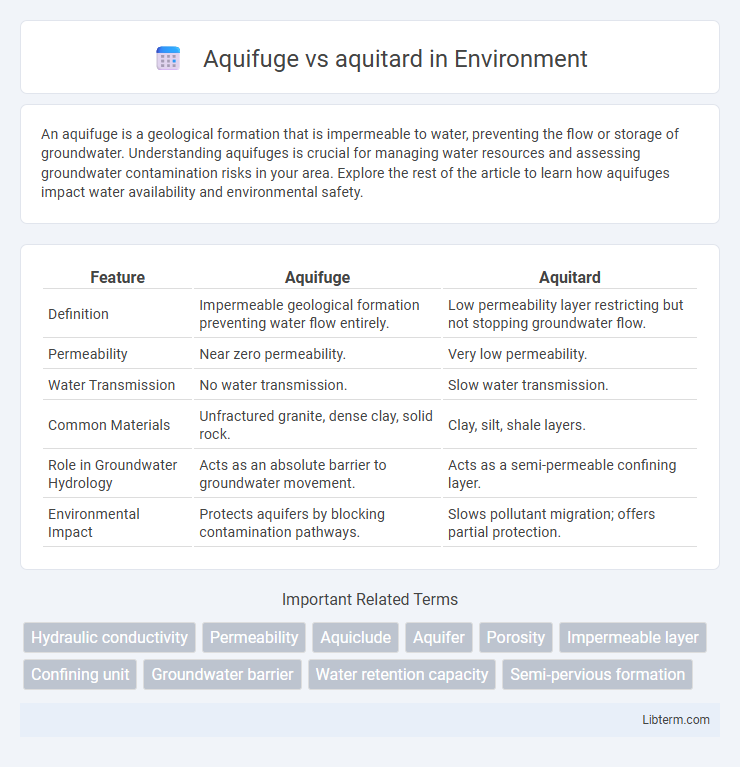An aquifuge is a geological formation that is impermeable to water, preventing the flow or storage of groundwater. Understanding aquifuges is crucial for managing water resources and assessing groundwater contamination risks in your area. Explore the rest of the article to learn how aquifuges impact water availability and environmental safety.
Table of Comparison
| Feature | Aquifuge | Aquitard |
|---|---|---|
| Definition | Impermeable geological formation preventing water flow entirely. | Low permeability layer restricting but not stopping groundwater flow. |
| Permeability | Near zero permeability. | Very low permeability. |
| Water Transmission | No water transmission. | Slow water transmission. |
| Common Materials | Unfractured granite, dense clay, solid rock. | Clay, silt, shale layers. |
| Role in Groundwater Hydrology | Acts as an absolute barrier to groundwater movement. | Acts as a semi-permeable confining layer. |
| Environmental Impact | Protects aquifers by blocking contamination pathways. | Slows pollutant migration; offers partial protection. |
Introduction to Aquifuge and Aquitard
Aquifuges are geological formations that completely prevent water flow due to their impermeability, acting as absolute barriers in groundwater systems. Aquitards, in contrast, are semi-permeable layers that significantly restrict but do not entirely stop water movement, often composed of clay or silt. Understanding the differences between aquifuges and aquitards is essential for hydrogeologists when evaluating groundwater flow and resource management.
Definition of Aquifuge
An aquifuge is a geological formation that is entirely impermeable to water, preventing the passage of groundwater through it. Unlike an aquitard, which allows limited water movement due to its low permeability, an aquifuge acts as a complete barrier, blocking any groundwater flow. Aquifuges are crucial in hydrogeology for defining boundaries between aquifers and restricting water movement in subsurface environments.
Definition of Aquitard
An aquitard is a geologic formation characterized by low permeability that restricts groundwater flow but does not completely block it, acting as a semi-confining layer. Unlike an aquifuge, which is impermeable and prevents any water movement, an aquitard allows limited water passage through fine-grained materials such as clay or silt. Understanding the distinction between aquitards and aquifuges is essential for groundwater modeling and assessing aquifer recharge potential.
Key Differences Between Aquifuge and Aquitard
Aquifuges are impermeable geologic formations that completely prevent water flow, often composed of dense rock or clay, whereas aquitards are semi-permeable layers that restrict but do not entirely block groundwater movement, typically consisting of silt or shale. Aquifuges act as absolute barriers to groundwater recharge and flow, while aquitards allow slow percolation, impacting water availability and contaminant transport differently. Understanding these distinctions is crucial for effective groundwater management and predicting aquifer recharge rates.
Hydrogeological Characteristics
Aquifuges are geological formations with extremely low permeability, effectively preventing groundwater flow and acting as impermeable barriers, while aquitards possess low but not negligible permeability, allowing limited groundwater movement. Aquitards typically consist of clay or silt layers that retard water flow, influencing vertical hydraulic conductivity and creating semi-permeable boundaries in aquifers. The contrasting hydrogeological characteristics of aquifuges and aquitards are critical for groundwater modeling, well design, and contaminant transport prediction.
Examples of Aquifuge Materials
Aquifuge materials include solid rock formations such as granite, gneiss, and unfractured basalt that completely inhibit water movement due to their dense and impermeable nature. These materials contrast with aquitards like clay and shale, which restrict but do not entirely prevent groundwater flow. Understanding the distinction between aquifuge and aquitard materials is essential for groundwater management and hydrogeological studies.
Examples of Aquitard Materials
Aquitard materials include clay, silt, and shale, which are characterized by low permeability and slow water transmission. These materials effectively restrict water flow, distinguishing aquitards from aquifuges that completely prevent water movement. Understanding the composition of aquitards is crucial for groundwater management and environmental protection.
Role in Groundwater Movement
Aquifuges act as impermeable layers that completely prevent groundwater flow, effectively isolating aquifers and restricting water movement. Aquitards, while also inhibiting water flow, allow limited groundwater passage due to their low permeability, often slowing but not stopping the movement. These differences influence groundwater recharge rates, contaminant migration, and the efficiency of water extraction from aquifers.
Importance in Water Resource Management
Aquifuges and aquitards play crucial roles in water resource management by controlling groundwater flow and recharge rates. Aquifuges, being impermeable layers such as unfractured igneous or metamorphic rock, act as barriers preventing water movement, thus protecting aquifers from contamination and over-extraction. Aquitards, composed of low-permeability materials like clay or shale, restrict but do not completely stop groundwater flow, helping to regulate recharge and discharge processes critical for sustainable water supply planning.
Conclusion: Aquifuge vs Aquitard
Aquifuges are impermeable geological formations that prevent any groundwater flow, effectively acting as absolute barriers. Aquitards, by contrast, are semi-permeable layers that restrict but do not entirely stop water movement between aquifers. Understanding the distinction between aquifuge and aquitard is critical for groundwater management, influencing well placement and contamination risk assessment.
Aquifuge Infographic

 libterm.com
libterm.com